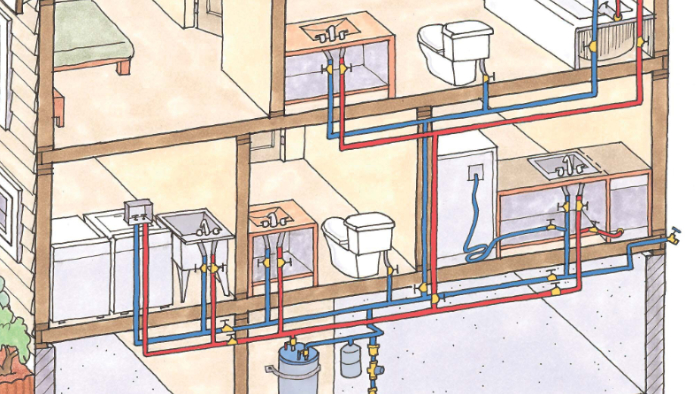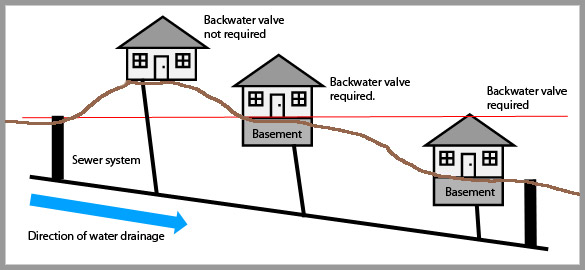What Your Home's Plumbing System Works: Anatomy
What Your Home's Plumbing System Works: Anatomy
Blog Article
On this page down the page you can get lots of quality data on the subject of Anatomy of a House: Understanding the Components.

Recognizing how your home's pipes system works is crucial for each house owner. From providing clean water for alcohol consumption, food preparation, and showering to safely removing wastewater, a well-maintained plumbing system is essential for your family's wellness and convenience. In this detailed guide, we'll discover the elaborate network that makes up your home's plumbing and deal suggestions on maintenance, upgrades, and handling typical issues.
Introduction
Your home's pipes system is more than just a network of pipelines; it's a complex system that ensures you have access to tidy water and efficient wastewater removal. Understanding its parts and how they interact can aid you protect against pricey repair work and ensure whatever runs efficiently.
Fundamental Components of a Pipes System
Pipelines and Tubes
At the heart of your plumbing system are the pipelines and tubes that bring water throughout your home. These can be made of different products such as copper, PVC, or PEX, each with its advantages in regards to sturdiness and cost-effectiveness.
Fixtures: Sinks, Toilets, Showers, and so on.
Fixtures like sinks, commodes, showers, and tubs are where water is made use of in your house. Comprehending how these components connect to the plumbing system aids in diagnosing issues and preparing upgrades.
Shutoffs and Shut-off Factors
Valves control the circulation of water in your pipes system. Shut-off valves are vital throughout emergencies or when you require to make repairs, permitting you to isolate parts of the system without interrupting water flow to the entire residence.
Water System
Main Water Line
The major water line connects your home to the local water supply or a private well. It's where water enters your home and is distributed to various components.
Water Meter and Pressure Regulatory Authority
The water meter steps your water usage, while a pressure regulator makes certain that water moves at a safe pressure throughout your home's plumbing system, protecting against damage to pipelines and fixtures.
Cold Water vs. Hot Water Lines
Understanding the distinction between cold water lines, which supply water directly from the main, and hot water lines, which carry heated water from the hot water heater, aids in repairing and planning for upgrades.
Drainage System
Drain Pipes Pipeline and Traps
Drain pipes lug wastewater far from sinks, showers, and commodes to the sewer or septic system. Traps stop sewer gases from entering your home and likewise trap particles that might create clogs.
Air flow Pipes
Ventilation pipes enable air right into the drain system, preventing suction that could slow down drain and create catches to vacant. Correct air flow is crucial for preserving the integrity of your plumbing system.
Relevance of Proper Drain
Ensuring appropriate water drainage protects against backups and water damage. Routinely cleansing drains pipes and maintaining catches can stop expensive repairs and extend the life of your plumbing system.
Water Heating Unit
Sorts Of Water Heaters
Hot water heater can be tankless or typical tank-style. Tankless heaters warm water as needed, while tanks save warmed water for prompt usage.
Upgrading Your Plumbing System
Factors for Upgrading
Updating to water-efficient fixtures or changing old pipelines can enhance water high quality, lower water bills, and raise the value of your home.
Modern Plumbing Technologies and Their Advantages
Explore innovations like smart leak detectors, water-saving bathrooms, and energy-efficient water heaters that can save cash and reduce environmental effect.
Price Considerations and ROI
Determine the ahead of time prices versus long-term cost savings when considering pipes upgrades. Several upgrades spend for themselves via decreased utility expenses and less repair services.
Exactly How Water Heaters Connect to the Plumbing System
Comprehending exactly how hot water heater connect to both the cold water supply and warm water circulation lines assists in detecting concerns like inadequate hot water or leaks.
Maintenance Tips for Water Heaters
Routinely purging your hot water heater to remove debris, checking the temperature level settings, and checking for leakages can prolong its life expectancy and improve power effectiveness.
Usual Pipes Issues
Leaks and Their Reasons
Leakages can happen due to maturing pipes, loosened fittings, or high water pressure. Resolving leaks quickly protects against water damages and mold and mildew development.
Clogs and Blockages
Obstructions in drains and bathrooms are usually triggered by purging non-flushable products or a buildup of grease and hair. Utilizing drain screens and being mindful of what decreases your drains pipes can avoid clogs.
Indicators of Plumbing Issues to Expect
Low tide stress, sluggish drains pipes, foul odors, or uncommonly high water costs are indications of potential plumbing issues that ought to be resolved quickly.
Pipes Upkeep Tips
Routine Assessments and Checks
Arrange yearly plumbing examinations to capture issues early. Look for indications of leakages, rust, or mineral build-up in faucets and showerheads.
Do It Yourself Upkeep Tasks
Easy jobs like cleaning tap aerators, looking for bathroom leaks making use of dye tablets, or protecting revealed pipelines in cold environments can prevent significant plumbing problems.
When to Call a Specialist Plumber
Know when a pipes issue needs expert competence. Attempting complicated repair work without proper expertise can result in even more damage and higher repair expenses.
Tips for Lowering Water Use
Easy behaviors like fixing leaks quickly, taking shorter showers, and running complete lots of laundry and dishes can preserve water and reduced your utility costs.
Eco-Friendly Plumbing Options
Consider sustainable pipes materials like bamboo for flooring, which is durable and green, or recycled glass for counter tops.
Emergency Readiness
Steps to Take Throughout a Plumbing Emergency
Know where your shut-off valves are located and how to shut off the water supply in case of a burst pipeline or major leakage.
Importance of Having Emergency Situation Contacts Useful
Keep call info for neighborhood plumbing technicians or emergency services conveniently available for quick feedback throughout a plumbing dilemma.
Environmental Effect and Conservation
Water-Saving Components and Devices
Installing low-flow faucets, showerheads, and toilets can dramatically reduce water usage without sacrificing performance.
Do It Yourself Emergency Situation Fixes (When Applicable).
Short-term fixes like utilizing air duct tape to spot a leaking pipeline or positioning a bucket under a trickling tap can minimize damage up until an expert plumbing technician gets here.
Conclusion.
Understanding the makeup of your home's plumbing system encourages you to preserve it successfully, conserving money and time on repair services. By complying with routine upkeep regimens and staying educated concerning modern-day plumbing innovations, you can guarantee your plumbing system runs successfully for years to find.
The Anatomy of Your Home s Plumbing System
Understanding the anatomy of your home s plumbing system is essential for any homeowner. It not only helps in identifying potential issues but also facilitates effective communication with professionals when repairs or upgrades are needed. Your home s plumbing system is more than just pipes and faucets; it s a complex network that ensures the efficient and hygienic flow of water in and out of your house. In this blog, we ll dissect the crucial components of your home s plumbing system. For those in Antelope Valley, Brock Plumbing is your trusted partner for all your plumbing needs, ensuring your system functions smoothly and efficiently.
Water Supply System
Main Water Line: This is where your home s plumbing system begins. The main water line connects your home to the public water supply or a private well. Pipes and Shut-off Valves: Pipes distribute water throughout your home. Shut-off valves are crucial for controlling the flow of water and making repairs without shutting off the entire system. Drainage System
Drain Pipes: These pipes carry waste and water away from sinks, toilets, and showers. Vents: Vents allow sewer gases to escape and help maintain proper pressure in the drainage pipes, ensuring efficient flow of wastewater. Traps: Every fixture has a trap, a U-shaped pipe that holds water and prevents sewer gases from entering your home. The most common is the P-trap under sinks. Fixtures and Appliances
Fixtures and appliances are the most interacted with parts of your plumbing system. They include sinks, toilets, showers, dishwashers, and washing machines. Each fixture and appliance has its own supply and drainage connection, ensuring they receive clean water and can dispose of wastewater effectively.
Water Heating System
Your water heater is a crucial component, providing hot water to various fixtures and appliances in your home. It can be tank-based or tankless, with each type having its own set of advantages and maintenance requirements. Regular maintenance is essential to ensure efficient operation and extend the lifespan of the unit.
Sump Pump
In areas prone to flooding or with high water tables, a sump pump is an essential part of the plumbing system. It s installed in the lowest part of your basement or crawlspace and pumps out water that accumulates, preventing flooding and protecting your home from water damage.
Septic System
Homes that are not connected to a municipal sewer system have a septic system and an underground wastewater treatment structure. Understanding how to maintain your septic system is crucial to prevent backups, odors, and early system failure.
Conclusion
Your home s plumbing system is a complex and essential network, ensuring the efficient and hygienic flow of water in and out of your property. Understanding its key components helps in maintaining it properly and identifying issues before they escalate into major problems. For residents in Antelope Valley, Brock Plumbing is dedicated to providing top-notch services, ensuring that every part of your plumbing system is in perfect working order. Trust our team of professionals to handle all your plumbing needs, ensuring your home remains comfortable, safe, and well-maintained.
https://brockplumbinganddrains.com/blog/the-anatomy-of-your-homes-plumbing-system/

I was introduced to that report about Plumbing Installation 101: All You Need to Know through a buddy on another website. Do you know about another individual who is curious about Plumbing Installation 101: All You Need to Know? Please feel free to promote it. Thank you for your time invested reading it.
Call Today Report this page